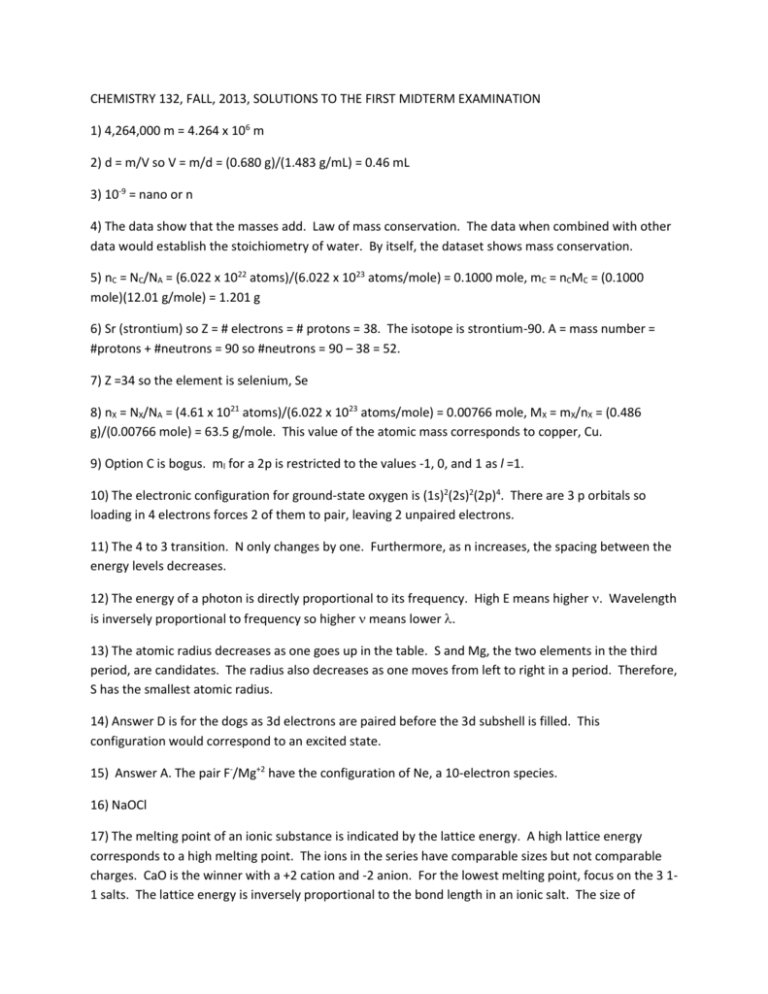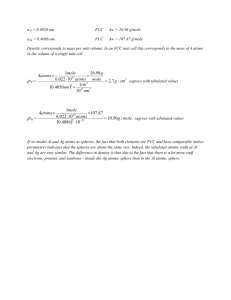First midterm exam
advertisement

CHEMISTRY 132, FALL, 2013, SOLUTIONS TO THE FIRST MIDTERM EXAMINATION 1) 4,264,000 m = 4.264 x 106 m 2) d = m/V so V = m/d = (0.680 g)/(1.483 g/mL) = 0.46 mL 3) 10-9 = nano or n 4) The data show that the masses add. Law of mass conservation. The data when combined with other data would establish the stoichiometry of water. By itself, the dataset shows mass conservation. 5) nC = NC/NA = (6.022 x 1022 atoms)/(6.022 x 1023 atoms/mole) = 0.1000 mole, mC = nCMC = (0.1000 mole)(12.01 g/mole) = 1.201 g 6) Sr (strontium) so Z = # electrons = # protons = 38. The isotope is strontium-90. A = mass number = #protons + #neutrons = 90 so #neutrons = 90 – 38 = 52. 7) Z =34 so the element is selenium, Se 8) nX = NX/NA = (4.61 x 1021 atoms)/(6.022 x 1023 atoms/mole) = 0.00766 mole, MX = mX/nX = (0.486 g)/(0.00766 mole) = 63.5 g/mole. This value of the atomic mass corresponds to copper, Cu. 9) Option C is bogus. ml for a 2p is restricted to the values -1, 0, and 1 as l =1. 10) The electronic configuration for ground-state oxygen is (1s)2(2s)2(2p)4. There are 3 p orbitals so loading in 4 electrons forces 2 of them to pair, leaving 2 unpaired electrons. 11) The 4 to 3 transition. N only changes by one. Furthermore, as n increases, the spacing between the energy levels decreases. 12) The energy of a photon is directly proportional to its frequency. High E means higher . Wavelength is inversely proportional to frequency so higher means lower . 13) The atomic radius decreases as one goes up in the table. S and Mg, the two elements in the third period, are candidates. The radius also decreases as one moves from left to right in a period. Therefore, S has the smallest atomic radius. 14) Answer D is for the dogs as 3d electrons are paired before the 3d subshell is filled. This configuration would correspond to an excited state. 15) Answer A. The pair F-/Mg+2 have the configuration of Ne, a 10-electron species. 16) NaOCl 17) The melting point of an ionic substance is indicated by the lattice energy. A high lattice energy corresponds to a high melting point. The ions in the series have comparable sizes but not comparable charges. CaO is the winner with a +2 cation and -2 anion. For the lowest melting point, focus on the 3 11 salts. The lattice energy is inversely proportional to the bond length in an ionic salt. The size of cations and anions increase as one goes down the periodic table. KCl, with the largest cation and anion in the set, has the largest bond length and therefore the lowest melting point. 18) If M+2 has the configuration of Ar, it has 18 electrons so M has 20 electrons. Z = 20 means Ca. 19) CO3-2 = carbonate (nitrate is NO3-, hydroxide is OH-, ammonium is NH4+) 20) When transition metals are ionized, the ns electrons are removed before the (n-1)d as they are farther from the nucleus and shielded from the nucleus by the (n-1)d electrons. 21) a) nNa = NNa/NA = (47 atoms)?(6.022 x 1023 atoms/mole) = 7.8805 x 1023 mole, mNa = nNaNA = (7.8805 x 1023 mole)(23.989770 g/mole) = 1.872 x 10-21 g. The number of atoms is exact so the precision in the mass is limited by the precision of NA and MNA. b) d = m/V so V = m/d = (1.872 x 10-21 g)/(0.971 g/cm3) = 1.93 x 10-21 g/cm3. 22) a) Ti, Z =22, [Ar] (4s)2(3d)2 b) P, Z = 15, [Ar] (3s)2(3p)3. Fill the 3s subshell with two paired electrons. Half fill the 3p subshell, one electron peer orbital, with unpaired electrons. c) Silver is one electron short of filling the 4d subshell. However, this is an anomalous case. One of the 5s electrons is moved into the 4d subshell, thus filling it. [Kr](5s)1(4d)10. There is no simple, rigorous explanation for the anomaly. The 5s electron is removed to produce the Ag(I) cation which has the configuration . [Kr](4d)10. d) The addition of an electron allows iodine to fill its subshell. [Kr](5s)2(4d)10(5p)6. Fill all the boxes and pair all electron spins. 23) Note that the atomic abundances are not equal so a weighted average is required. <M> = (31.97207070 amu)(0.9443) + (32.97145843 amu)(0.0076) + (33.96786665 amu)(0.0429) + (35.96708062 amu)(0.0002) = 32.07 amu. This corresponds to sulfur, S. 24) E = h = hc/ = (6.6260 x 10-34 J-s)(2.9979 x 108 m/s)/(89.3 x 10-9 m) = 2.22 x 10-18 J/photon. E(per mole) = NAE = (6.022 x 1023 photons/mole)(2.22 x 10-18 J/photon) = 1.34 x 106 J = 1340 kJ 24) (de Broglie) = h/p = h/(mv) = (6.626 x 10-34 J-s)/[(12.674 x 10-27 kg)(2.85 x 108 m/s)] = 1.39 x 10-15 m = 1.39 x 10-6 nm. N.B. Use SI units so express m in kg. 1 meter = 109 nanometer.





